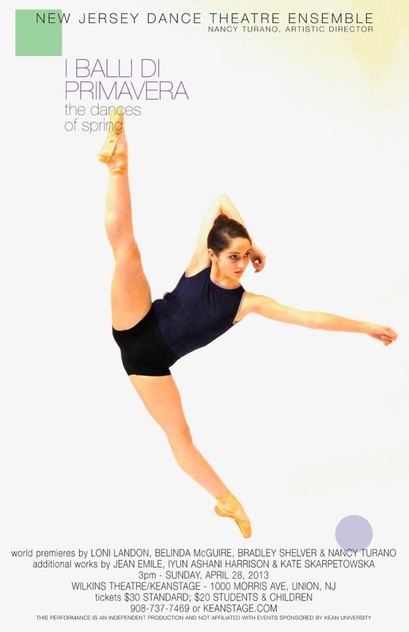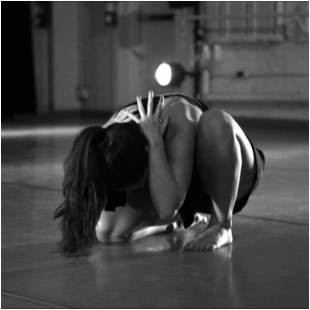 Gabrielle in her senior year at NJDTE, when she graced the Spring 2013 poster.
Gabrielle in her senior year at NJDTE, when she graced the Spring 2013 poster. I’ve always known that I am extremely flexible. Ever since I was given the nickname “Gumby” back when I was ten (yes, like the little green rubber guy), I’ve known that I am not necessarily normal. Over the years, especially with the New Jersey Dance Theatre Ensemble and Ms. Turano’s knowledge, I’ve been able to build the strength to finally begin to control what my body does.
My curiosity about my flexibility stemmed a strong interest in orthopedics and sports medicine. I found myself doing research on what caused hypermobility, taking anatomy classes, and doing presentations on what made my body so much different than everyone else’s. This interest led me to attend The George Washington University, where I am able to explore dance and my medical interests at the same time. Throughout my first year of school, I was able to expand my knowledge on extreme flexibility and learn more about what makes my body unique. At this point I thought I had a pretty good handle on what was going on with me and my anatomy, however I didn’t truly know where my flexibility came from until about a year ago.
Last summer, I found myself more sedentary than usual. I was taking exercise classes with my mom, but a finger injury kept me sidelined for a while. During this time I found that the more simple physical activities, such as walking up a flight of stairs, became more difficult – every time I would complete a task, I found that my heart rate was higher than normal. I started keeping track of what my heart rate would be after I walked up a flight of stairs, and when I realized that it was around 130-140 beats per minute every time, I knew I needed to see someone.
I went to the cardiologist in August and took a stress test. The results came back abnormal, and my body couldn’t handle it – I had chest pain, chest pressure, dizziness, and fatigue all from walking on an incline. I was automatically told to avoid all forms of activity that could put some sort of stress on my body, such as carrying heavy items and walking up stairs. This unfortunately included dance; I couldn’t take any dance classes that fall semester, or perform in GW’s end-of-semester showcase, which was heartbreaking. This led to more cardiologist appointments to try to figure out what was going on.
Meanwhile, in light of my heart issues, I decided that same month to see a geneticist about where my flexibility came from. My personal research on the subject came to a halt, and with the advice of the physical therapist I was working for, I figured it would be best to see exactly what was going on. The geneticist walked into the examination room, bent my joints in a few weird ways, and automatically diagnosed me with what I’ve always lived with – Ehlers-Danlos Syndrome (EDS).
In every ligament and tendon in your body, you have three types of proteins: collagen, which keeps the connective tissue strong; elastin, which lets the connective tissue stretch and release; and reticular proteins, which holds everything in place. Ehlers-Danlos Syndrome is a genetic condition that involves the lack of collagen in the connective tissues of the body, so my joints are prone to dislocations and other connective tissues in my body are more elastic than normal. There are multiple types of EDS, and my type is known for joint hypermobility and vulnerability to joint pain in my future, which means if I don’t take care of myself, I can start feeling joint pain in about ten years or so. My type of EDS is also linked to another syndrome, Postural Orthostatic Tachycardia Syndrome (POTS), and after all of my cardiac tests, and nearly passing out doing them, I found that I had that as well.
My EDS, as mentioned above, involves the increased elasticity of all of the connective tissues in my body, which means instead of just my ligaments and tendons being affected, my blood vessels are as well. The lack of rigidity of my blood vessel walls makes it much harder for them to maintain a healthy blood pressure, therefore my resting blood pressure is much lower than normal. This elasticity also makes it very hard for my blood pressure to stay consistent, and whenever I change my posture my blood pressure drops even further, and my heart rate increases to try to compensate for it. Postural Orthostatic Tachycardia Syndrome is exactly that – every time I change my posture (i.e. going from lying down to sitting up) my blood pressure drops and my heart rate increases to try to counteract the drop.
 Gabrielle on stage at The George Washington University.
Gabrielle on stage at The George Washington University. Nowadays, I share my story proudly. I’ve embraced my conditions so much to the point that I tell random people I’ve just met about my weird thumbs and low blood pressure. I regularly see my cardiologist here in DC to monitor my valve prolapse and my blood pressure. I take a mild steroid every morning to help retain salt in my kidneys to keep my blood pressure up, and I have to eat a lot of salt and drink a lot of water to help maintain a normal blood pressure. I also do more cardio now than I ever have before; it turns out that the more stamina I have the fewer POTS symptoms I feel, and because I’ve been dancing my whole life I never knew I had POTS, but I’ve had it all along. In addition, I do a lot of strength training and physical therapy to help strengthen my joints so I don’t dislocate them as often as I usually do. I’ve learned what I had to do to make sure I stay healthy, and I’ve learned to love the weird way my body works. And, I’m back to continuing my dance major and performing at GW.
I think I’ve also embraced this so much that it’s edited my career path. I’ve always wanted to go into orthopedics, but now I want to do research on the genetics of athleticism and what necessarily makes people more physically able or physically challenged. Our genes control pretty much everything in our body, so what exactly is it that makes us physically able to dance? What makes us more flexible or stronger than others? I also want to do research on Ehlers-Danlos – it is known that it is a genetic disease, but they do not know the location of the EDS gene for my specific type of EDS, so there are still many mysteries behind the syndrome. What I thought was a stopping point in my research before has now become a vast expanse of questions waiting to be answered.
I think my story just goes to show that it’s really important to make sure that you know exactly what your body needs to be healthy and strong. Every body is different and has its own individual needs, and it is extremely important to make sure that you take care of it properly. Along the same lines, it’s also very important to embrace what life gives to you. Use life experiences to your benefit instead of dwelling on them. Don’t let bumps in the road affect you. I know that my diagnoses have changed my life, but I can tell you right now that they have only changed it for the better. If you see me as some famous sports orthopedist/Ehlers-Danlos specialist in the future, this experience is exactly why.

